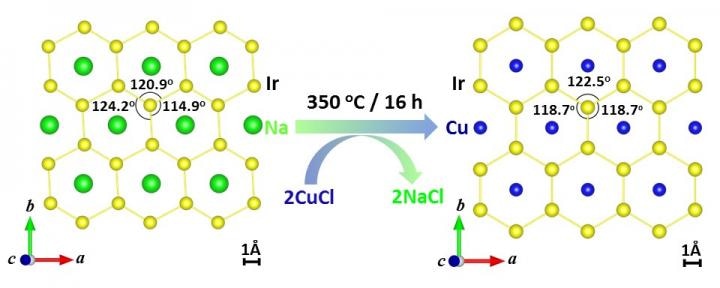Oct 24 2017
An elusive honeycomb-structured material has been developed by researchers from Boston College and Harvard. This new material is capable of frustrating the magnetic properties inside it in order to develop a chemical entity called "spin liquid," long theorized as a gateway to the free-flowing properties of quantum computing, based on a new report in the Journal of the American Chemical Society.
 Scientists from Boson College and Harvard turned to copper to create a first-of-its-kind iridate -- Cu2IrO3 -- where the natural magnetic order is disrupted, a state known as geometric frustration. CREDIT: Boston College
Scientists from Boson College and Harvard turned to copper to create a first-of-its-kind iridate -- Cu2IrO3 -- where the natural magnetic order is disrupted, a state known as geometric frustration. CREDIT: Boston College
The first-of-its-kind copper iridate metal oxide - Cu2IrO3 - is one where the natural magnetic order is disrupted, a state referred to as geometric frustration, stated Boston College Assistant Professor of Physics Fazel Tafti, a key author of the study, titled Cu2IrO3: a new magnetically frustrated honeycomb iridate.
The copper iridate is an insulator and its electrons are immobilized in the solid, however, they can still transport a magnetic moment called "spin". The transport of free spins in the material permits a flow of quantum information.
Proposed in 2006 by Cal Tech Professor of Physics Alexei Kitaev, the Kitaev model states that a hexagonal honeycomb structure offered a favorable route to geometric frustration and thus to quantum spin liquid.
Only two honeycomb lattices have been developed successfully as part of an attempt to fulfill Kitaev's model: a sodium iridate (Na2IrO3) and a lithium iridate (Li2IrO3). However both fell short of achieving a suitable spin liquid due to magnetic ordering, said Tafti, who co-authored the paper along with Boston College post-doctoral researchers Mykola Abramchuk and Jason W. Krizan, BC Adjunct Professor of Chemistry and Director of Advanced Chemistry Laboratories Kenneth R. Metz, and Harvard's David C. Bell and Cigdem Ozsoy-Keskinbora.
Tafti and his team turned to copper because of its perfect atomic size, which is between sodium and lithium. Their studies in x-ray crystallography discovered subtle flaws in the honeycombs formed in the sodium and lithium iridates. The team swapped copper for sodium in what Tafti referred to as a comparatively simple "exchange" reaction. The effort resulted in the production of the first oxide of copper and iridium, Tafti said.
Copper is ideally suited to the honeycomb structure, there is almost no distortion in the honeycomb structure.
Fazel Tafti, a key author of the study
After a decade following the original prediction of quantum spin liquid on a honeycomb lattice by Kitaev, the team of young scientists from Boston College succeeded in developing a material that almost exactly relates to the Kitaev model, Tafti said.
Tafti's lab will follow the "exchange" chemistry path in order to produce new forms of honeycomb materials with more interesting magnetic properties, he stated.